GEZELLIG, ANYONE?
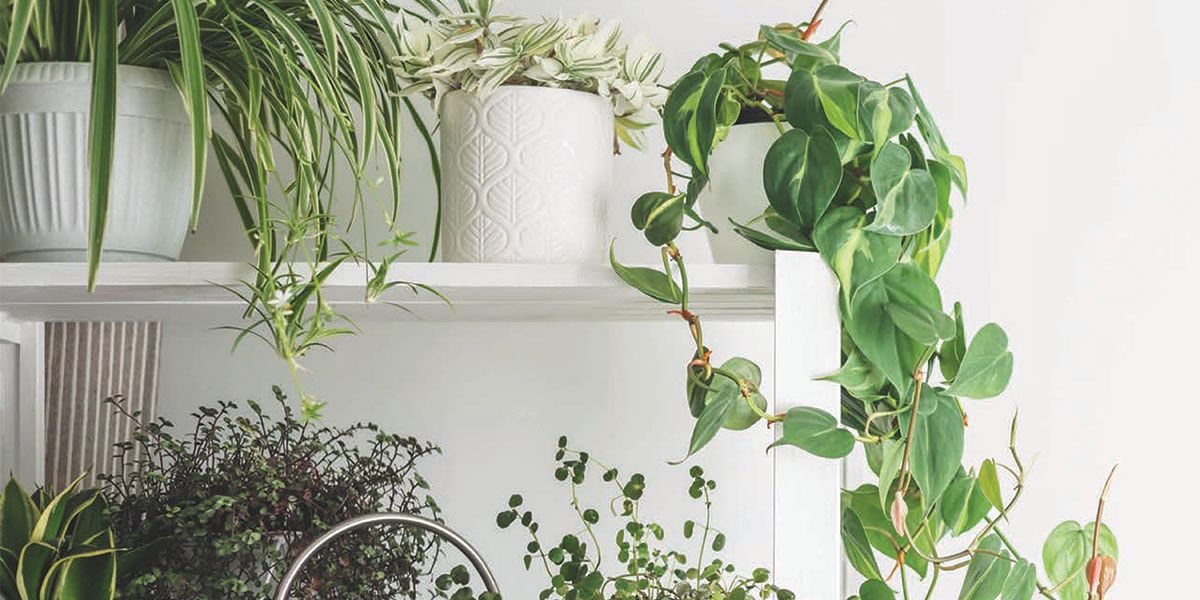
Becoming a Responsible Plant Parent
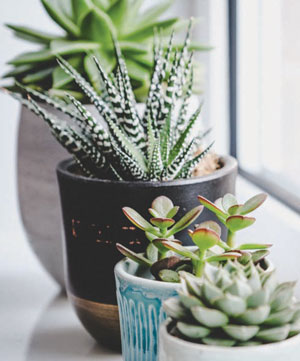 The humble houseplant has the power to improve indoor air quality at home or at work while elevating our moods one leaf at a time. For some, plants can even provide what the Dutch call “gezellig,” a word describing that feeling of coziness, comfort and relaxation.
The humble houseplant has the power to improve indoor air quality at home or at work while elevating our moods one leaf at a time. For some, plants can even provide what the Dutch call “gezellig,” a word describing that feeling of coziness, comfort and relaxation.
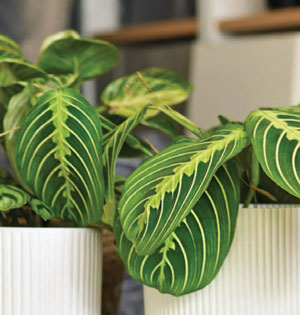 Because a plant is a living being, it needs a certain amount of TLC in the form of water, light and occasionally fertilizer. And even if you haven’t had much success with nurturing plants in the past, with a few pointers and the benefit of careful research, you can create your own indoor jungle.
Because a plant is a living being, it needs a certain amount of TLC in the form of water, light and occasionally fertilizer. And even if you haven’t had much success with nurturing plants in the past, with a few pointers and the benefit of careful research, you can create your own indoor jungle.
Before embarking on plant parenthood, consider the following questions.
- Which room do you spend the most time in?
- How much natural light does that room get?
- Is the space suitable for a small, medium or large plant?
- How much time are you willing to spend on a plant’s care?
With answers to these questions, a novice plant parent can begin selecting indoor plants that are not just likely to survive, but to thrive.
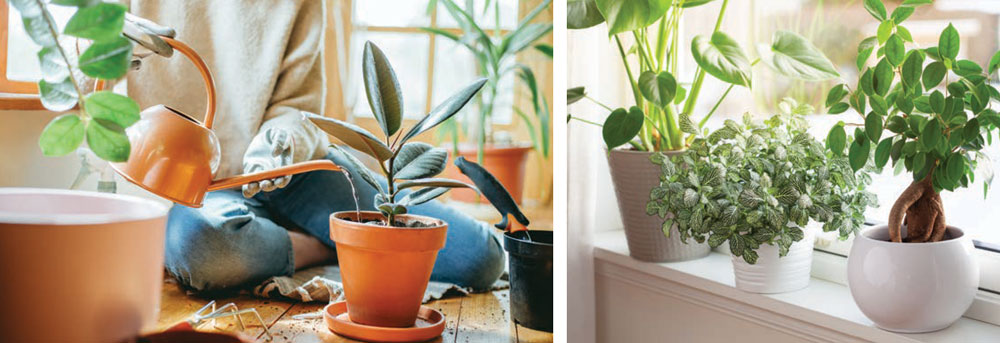
Easy-to-grow houseplants
Sources of prime plant stock and related growing products are more numerous than ever. Close to home sources include big box retailers, as well as local plant nurseries, florists and farmers markets. Below find some of the least challenging varieties (listed in alphabetical order) with which to join the ranks of plant parents. Note in the descriptions the various light needs and watering requirements of these 10 houseplant varieties.
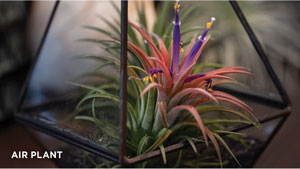 AIR PLANTS
AIR PLANTS
These unique, small sculptural plants need no soil, but they do require a 10-minute soak in water once a week. They can simply be placed alone on shelves or tables atop curated stacks of books, on windowsills or peeking out of ceramic vessels. A bonus is that air plants come in many varieties and will live for years with minimal care.
ALGERIAN IVY
This trailing ivy vine tolerates rooms without sunlight and needs only to be watered and pruned regularly. Place it on a tall shelf and watch it run down to the floor or on a bank of file cabinets and let it run across the tops. This plant is a great choice for offices.
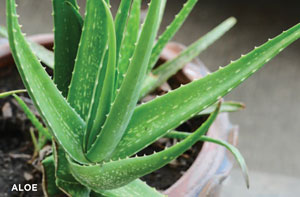 ALOE
ALOE
The aloe vera plant is a sun-loving succulent with the added benefit of sap that is a tried and true analgesic for the treatment of burns. Its spiked leaves make it an eye-catching addition to any room. Take care not to overwater this plant and be sure to place it in a tallish pot to prevent its leaves from touching any surface.
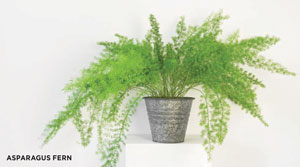 ASPARAGUS FERN
ASPARAGUS FERN
This plant tolerates indirect light well and needs only regular watering when the soil is dry; full sun scorches its leaves. Since its fronds cascade downward, it looks best in a hanging basket or on a pedestal. While this fern is decidedly low maintenance, expect some leaf drop and related clean up. Take care to avoid letting it become rootbound.
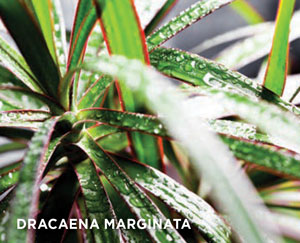 DRACAENA MARGINATA
DRACAENA MARGINATA
This popular houseplant has long, spiky, red-lined leaves that emanate from its center. It tolerates low light and is best planted so that none of its leaves touch anything, making it best suited to a hanging pot or pedestal.
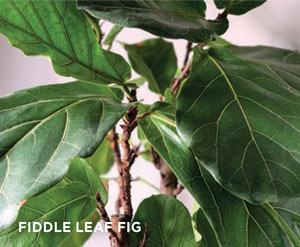 FIDDLE LEAF FIG
FIDDLE LEAF FIG
Water this large plant with African origins only when the top layer of soil is dry. It thrives in rainforest conditions, specifically huge deluges followed by long periods of drought. Place it in a non-drafty corner in a colorful pot to create a dramatic focal point in a room that gets bright, indirect light.
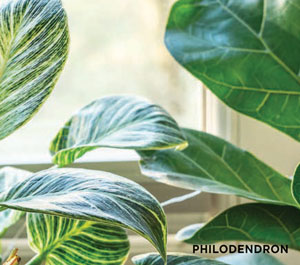 PHILODENDRON
PHILODENDRON
This dark green plant with heart-shaped leaves is super easy to grow and maintain and is one of the best trailers and/or climbers. Also known as the “sweetheart plant,” it thrives in bright, indirect light and needs to be watered only when its soil is almost dry to the touch. Best of all, philodendron can easily be propagated with just a few inches of snipped off vine placed in water or moist soil until roots form, creating a brand new baby plant. If nurtured properly, these plants can live for decades.
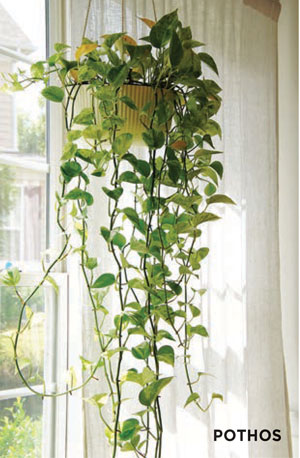 POTHOS
POTHOS
You will love the many varieties in color of this lush, fuss-free plant. Whether light silvery green or yellowy green with white spots, this trailing plant thrives on neglect and can withstand nearly pitch-black conditions, explaining the origin of its nickname “devil’s ivy.” This hardy houseplant can live for years, trailing prettily from high spots in your home or office. Beware of letting it hang down within reach of dogs or cats, though, since it is toxic to them.
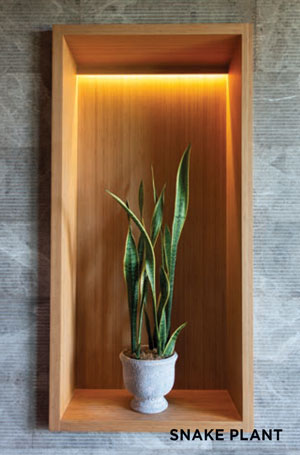 SNAKE PLANT
SNAKE PLANT
Indirect light is ideal for these tall plants also known as “mother-in-law’s tongue.” These thick, upright-leaved plants are typically sold when they are just 10-12 inches tall but can reach a couple of feet in height when mature. They benefit from light waterings when their soil has fully dried out. The snake plant looks sensational in an elevated planter in the corner of a room when young or in a large pot on the floor when mature.
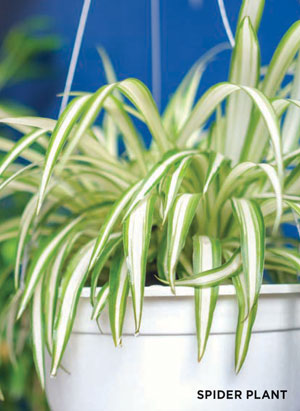 SPIDER PLANT
SPIDER PLANT
Infrequent waterings and bright, indirect light make this plant one of the easiest to care for and propagate. Show off its long, cascading, curved leaves by placing it in a hanging pot or on a pedestal where it won’t be crowded. Cut off any of its offshoots and root in water for a second fast-growing plant.
Important tips
One of the biggest plant parenting downfalls is overwatering, leading to root rot and limp, shriveled or rotting leaves. Poke a finger an inch into a plant’s soil, and water only if it is dry. Pay special attention to the pot’s material, and match it to the watering needs of your chosen plant. Be careful to watch for signs of a rootbound plant, repotting when roots show on the soil’s top or protrude from drainage holes. Experts recommend a pot only a couple of inches larger when repotting. Houseplants placed in optimally engineered environments will produce manifold benefits. ✦
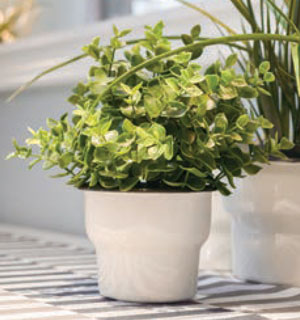
Go Faux
No green thumb? No problem! There are more artificial plants than ever, and some are so believable that you must touch them to determine if they are real. While dollar-store faux plants may suffice if viewed from afar, expect to pay more for those that will stand up to close scrutiny.
air plants, air quality, algerian ivy, aloe, asparagus fern, dracaena marginata, fiddle leaf fig, gezellig, houseplant, philodendron, pothos, Snake Plant, spider plant






